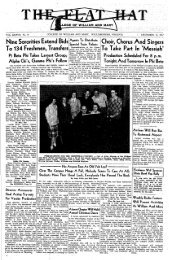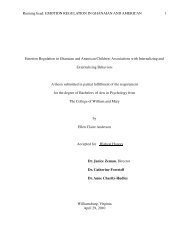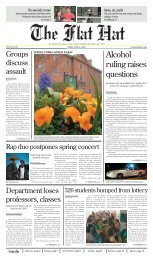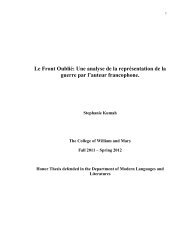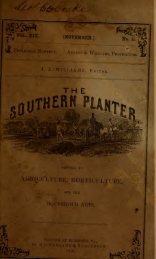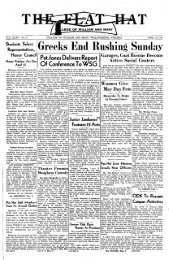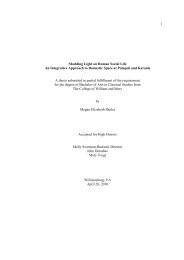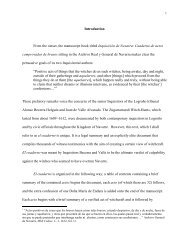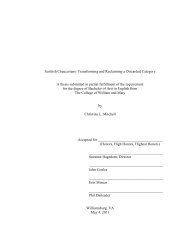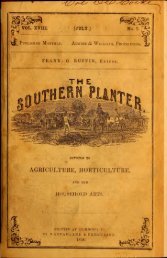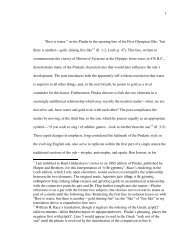Southern planter - The W&M Digital Archive
Southern planter - The W&M Digital Archive
Southern planter - The W&M Digital Archive
You also want an ePaper? Increase the reach of your titles
YUMPU automatically turns print PDFs into web optimized ePapers that Google loves.
1859.] THE SOUTHERN PLANTER. 409<br />
•with the most marked pecuniary bug<br />
Mr. Ruffin, of Virginia, estimates the increased<br />
value of reclaimed lands in Eastern<br />
Virginia, by marling and liming, from 1838<br />
to 1850, at some thirty millions of dollars.<br />
In the well known ease of a similar BUCCess<br />
from claying- a light soil by the celebrated<br />
Coke of Norfolk, afterwards Karl Leicester,'<br />
that gentleman doubled the value of his<br />
estates in Norfolkshire : and among numerous<br />
instances of immense improvement<br />
simply from drainage and deep plowing,<br />
with but little aid from fertilizers, may be<br />
mentioned one cited by Prof. Johnston of<br />
the Home farm at Ycstees, belonging to the<br />
Marquis of Twecdale, where the land, by<br />
these means, was raised in value eight times<br />
—from 5 shillings to 40 shillings rent per acre.<br />
<strong>The</strong>re are no reliable data from which we<br />
can now gather the progress of deterioration<br />
in productive lands in the United States, or<br />
the reclamation of exhausted lands; but the<br />
rapid increase in the use of guano, the most<br />
powerful of restoratives, indicates to some<br />
extent the increasing attention paid to fer-<br />
tilizing.<br />
<strong>The</strong> consumption of guano for 1855, as<br />
stated by Prof. Mapes, w r as about 140,000<br />
tons. <strong>The</strong> amount sold in England, during<br />
the year 1855, was stated by Mr. Nesbitt at<br />
210,000 tons being an increase of twenty<br />
per cent, on the consumption of 1854,<br />
which was also an increase of twenty per<br />
cent, over that of 1853 ; this increase has<br />
taken place in the face of a rise in the price,<br />
from forty-five to about eighty dollars per ton.<br />
It would seem proper that the schedules<br />
for the new Census, should embrace inqui-<br />
ries in regard to the deterioration or improvement<br />
of the soil, which maybe shown,<br />
not only by the ratio of crops to the acre at<br />
successive periods, but by the market value<br />
of the same lands at the stated intervals<br />
and that the schedules should also exhibit<br />
generally the quantity and prices of the various<br />
fertilizers in use—barn-yard manure<br />
firstly and chiefly, then guano, poudrette,<br />
lime, gypsum, marl, muck, and so forth, that<br />
are yearly devoted to the enrichment of our<br />
soils. Upon this item of manure insignifi-<br />
cant as it might seem to the unreflecting<br />
mind, depends the continuous prosperity of<br />
our country. This is the secret of England's<br />
Agricultural wealth. Mr. Webster, in his<br />
sketch of English Agriculture, quoted the<br />
extraordinary fact stated by M'Quecn, "that<br />
the value of the animal manure annually<br />
applied to the crops in England, at current<br />
prices, surpasses in value the wdiolc amount<br />
of its foreign commerce/' and he added,<br />
1<br />
there is do doubt thai it greatly exceeds it.'*<br />
<strong>The</strong> schedules might also advantageously<br />
give us, not simply the amount of new lands<br />
brought into cultivation, but of the worthless<br />
lands that have been reclaimed by<br />
drainage.<br />
In almost all the States extensive tracts<br />
of swamp lands are found, not only unfit<br />
for cultivation, but frequently indueive of<br />
that fearful scourge of health and happiness,<br />
fever and ague, that year after year<br />
prostrates the energies, and shortens the<br />
lives of tens of thousands of our countrymen.<br />
Large grants of these swamp lands have<br />
been gratuitously made by the Federal Government<br />
to the States, in the hope of their<br />
reclamation through measures to be adopted<br />
by the State Governments. Since 1849<br />
nearly sixty millions of acres have been<br />
thus granted.")" In the drainage of large<br />
tracts of land we have the benefit of the<br />
experience of Europe, especially Holland,<br />
where the Harlem Lake, thirty-three miles<br />
in circumference, and thirteen feet deep<br />
below the tide, has, since 1839, been converted<br />
into a most fertile tract, occupied by<br />
some two thousand inhabitants, and exhibiting<br />
fields of verdure, dotted with numerous<br />
cottages, and enlivened by cattle, horses and<br />
sheep, grazing on the fruitful meadows. <strong>The</strong><br />
lands thus reclaimed from the ocean are of<br />
extraordinary fertility, and are estimated as<br />
capable of supporting seventy thousand per-<br />
sons.<br />
Of the pecuniary results of drainage in<br />
this country Gov. Wright, of Indiana, quoted<br />
an example in a public address touching<br />
the marshy lands of that State embracing<br />
three thousand acres. He mentioned<br />
a farm of 1G0 acres which had been sold at<br />
five hundred dollars, and after an expenditure<br />
of two hundred dollars in drainage, was<br />
worth upwards of three thousand dollars, or<br />
an advance of more than 500 per cent.<br />
But, apa^t from these large tracts of<br />
overflowed lands, scarcely a farm in the<br />
country but would be improved by thorough<br />
drainage, and it would not be difficult to as-<br />
certain the number of acres under-drained in<br />
each year of the Census, nor the estimated<br />
* Webster's Works, Vol. I., p. 448.<br />
f See an interesting paper on drainage by<br />
Henry F. French, of Exeter, New Hampshire, in<br />
the Patent Office Reports for 1S56, page 1G0.



